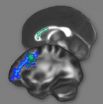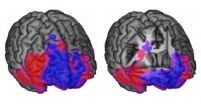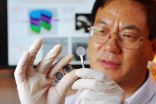(Press-News.org) Intensive preparation for the Law School Admission Test (LSAT) actually changes the microscopic structure of the brain, physically bolstering the connections between areas of the brain important for reasoning, according to neuroscientists at the University of California, Berkeley.
The results suggest that training people in reasoning skills – the main focus of LSAT prep courses – can reinforce the brain's circuits involved in thinking and reasoning and could even up people's IQ scores.
"The fact that performance on the LSAT can be improved with practice is not new. People know that they can do better on the LSAT, which is why preparation courses exist," said Allyson Mackey, a graduate student in UC Berkeley's Helen Wills Neuroscience Institute who led the study. "What we were interested in is whether and how the brain changes as a result of LSAT preparation, which we think is, fundamentally, reasoning training. We wanted to show that the ability to reason is malleable in adults."
The new study shows that reasoning training does alter brain connections, which is good news for the test prep industry, but also for people who have poor reasoning skills and would like to improve them. The findings are reported today (Wednesday, Aug. 22) in the open access journal Frontiers in Neuroanatomy.
"A lot of people still believe that you are either smart or you are not, and sure, you can practice for a test, but you are not fundamentally changing your brain," said senior author Silvia Bunge, associate professor in the UC Berkeley Department of Psychology and the Helen Wills Neuroscience Institute. "Our research provides a more positive message. How you perform on one of these tests is not necessarily predictive of your future success, it merely reflects your prior history of cognitive engagement, and potentially how prepared you are at this time to enter a graduate program or a law school, as opposed to how prepared you could ever be."
John D. E. Gabrieli, a professor of cognitive neuroscience at the Massachusetts Institute of Technology, who was not involved in the research, noted that researchers in the past have shown anatomical changes in the brain from simpler tasks, such as juggling or playing a musical instrument, but not for tasks as complex and abstract as thinking or reasoning, which involve many areas of the brain.
"I think this is an exciting discovery," he said. "It shows, with rigorous analysis, that brain pathways important for thinking and reasoning remain plastic in adulthood, and that intensive, real-life educational experience that trains reasoning also alters the brain pathways that support reasoning ability."
Harnessing brain's spatial areas improves deductive reasoning
The results also suggest that LSAT training improves students' reasoning ability by strengthening the connections between the left and right hemispheres of the brain. According to Bunge, director of the Building Blocks of Cognition Laboratory, deductive reasoning, such as language comprehension, taxes a predominantly left-hemisphere brain network, whereas spatial cognition taxes a predominantly right-hemisphere network.
"You could argue that, to the extent that you can employ spatial cognition to think through a verbal problem, you would have the edge," she said.
The structural changes were revealed by diffusion tensor imaging (DTI) scans of the brains of 24 college students or recent graduates before and after 100 hours of LSAT training over a three-month period. When compared with brain scans of a matched control group of 23 young adults, the trained students developed increased connectivity between the frontal lobes of the brain, and between frontal and parietal lobes.
"A lot of data on reasoning has suggested that it is left-hemisphere dominant," Mackey said. "But what we thought originally was that this kind of reasoning training would require repeated co-activation of frontal and parietal cortices on both sides of the brain. Our data are consistent with the idea that, while reasoning is left-hemisphere dominant, with training you learn to compensate; if you are not very good at reasoning, you start bringing on the right side."
The study focused on fluid reasoning –- that is, the ability to tackle a novel problem, which is central to IQ tests and has been shown to predict academic performance and performance in demanding careers, Bunge said.
"People assume that IQ tests measure some stable characteristic of an individual, but we think this whole assumption is flawed," Bunge said. "We think that the skills measured by an IQ test wax and wane over time depending on the individual's level of cognitive activity." One fascinating question, Gabrieli noted, is whether the brain changes observed in this study persist for months or longer after the training.
For the past decade, Bunge has studied the ability to integrate multiple pieces of information, "which we see as central to all tests of reasoning," she said.
LSAT prep students are highly motivated study group
Mackey and Bunge showed several years ago that children can improve their reasoning skills by regularly playing commercially available games that involve reasoning, though the researchers did not have the opportunity to test for actual physical changes in the brain. In searching for a program that provides adults with intensive reasoning training, they hit upon the idea of recruiting aspiring lawyers preparing for the LSAT. Allyson discovered that the company Blueprint Test Preparation offered 100 hours of class time, including 70 hours of reasoning training. With the company's cooperation, she recruited students as they signed up for a Blueprint LSAT course. This arrangement allowed her to test whether training changes brain structure in a group of highly motivated young adults.
Mackey and Bunge tested for changes in the white matter of the brain, the brain tissue that contains the connections between the brain's neurons. These connections, called axons, are surrounded by a variety of support cells called glia, some of which form myelin that insulates the axons and speeds the passage of signals. In animal studies, increased myelination and glial support cells are associated with learning, and a recent study found that some of these glial cells provide energy to the axons.
Using diffusion tensor imaging (DTI), they followed water movement in the white matter and found differences, on average, between the trained group and the control group. Specifically, the trained group showed a change in the directionality of water diffusion that is consistent with increased myelination. Also, near the boundary between the white matter and gray matter, the trained group showed a reduction in water diffusion, possibly because of more densely packed glial cells. While the real cause of the changes in water diffusion is unclear, the researchers said, it reflects an alteration in the microstructure of the brain associated with a change in cognitive activity.
"One thing that gives us confidence in these data is that a lot of these changes are in the tracts that connect frontal and parietal cortex, or between different hemispheres in those areas, and frontal and parietal regions are absolutely essential for reasoning," Bunge said. "So, we are seeing the changes exactly where we would expect to see them. And we think that they reflect strengthening of the connections between them."
"This work could inspire further research in non-human animals, because there seems to be a resurgence of interest in environmental influences on the brain," Bunge said, noting that, in the 1960s and '70s, UC Berkeley Professors Mark Rosenzweig and Marion Diamond conducted landmark research on the effects of environmental enrichment on behavior and brain anatomy in rats.
INFORMATION:
The work was funded by the National Institute of Neurological Diseases and Stroke of the National Institutes of Health, with the assistance of Blueprint Test Preparation. Graduate student Kirstie Whitaker also contributed to the research.
Intense prep for law school admission test alters brain structure
Brain imaging reveals stronger connections between verbal, spatial reasoning areas
2012-08-22
ELSE PRESS RELEASES FROM THIS DATE:
Study shows long-term effects of radiation in pediatric cancer patients
2012-08-22
For many pediatric cancer patients, total body irradiation (TBI) is a necessary part of treatment during bone marrow transplant– it's a key component of long term survival. But lengthened survival creates the ability to notice long term effects of radiation as these youngest cancer patients age. A University of Colorado Cancer Center study recently published in the journal Pediatric Blood & Cancer details these late effects of radiation.
"These kids basically lie on a table and truly do get radiation from head to toe. There is a little blocking of the lungs, but nothing ...
New laboratory test assesses how DNA damage affects protein synthesis
2012-08-22
RIVERSIDE, Calif. — Transcription is a cellular process by which genetic information from DNA is copied to messenger RNA for protein production. But anticancer drugs and environmental chemicals can sometimes interrupt this flow of genetic information by causing modifications in DNA.
Chemists at the University of California, Riverside have now developed a test in the lab to examine how such DNA modifications lead to aberrant transcription and ultimately a disruption in protein synthesis.
The chemists report that the method, called "competitive transcription and adduct ...
NASA sees an active tropical Atlantic again
2012-08-22
The Atlantic Ocean is kicking into high gear with low pressure areas that have a chance at becoming tropical depressions, storms and hurricanes. Satellite imagery from NASA's Terra and Aqua satellites have provided visible, infrared and microwave data on four low pressure areas. In addition, NASA's GOES Project has been producing imagery of all systems using NOAA's GOES-13 satellite to see post-Tropical Storm Gordon, Tropical Depression 9, and Systems 95L and 96L.
Tropical Storm Gordon is no longer a tropical storm and is fizzling out east of the Azores. Tropical Depression ...
Thinking and choosing in the brain
2012-08-22
PASADENA, Calif.—The frontal lobes are the largest part of the human brain, and thought to be the part that expanded most during human evolution. Damage to the frontal lobes—which are located just behind and above the eyes—can result in profound impairments in higher-level reasoning and decision making. To find out more about what different parts of the frontal lobes do, neuroscientists at the California Institute of Technology (Caltech) recently teamed up with researchers at the world's largest registry of brain-lesion patients. By mapping the brain lesions of these patients, ...
Multiple factors, including climate change, led to collapse and depopulation of ancient Maya
2012-08-22
TEMPE, Ariz. — A new analysis of complex interactions between humans and the environment preceding the 9th century collapse and abandonment of the Central Maya Lowlands in the Yucatán Peninsula points to a series of events — some natural, like climate change; some human-made, including large-scale landscape alterations and shifts in trade routes — that have lessons for contemporary decision-makers and sustainability scientists.
In their revised model of the collapse of the ancient Maya, social scientists B.L. "Billie" Turner and Jeremy "Jerry" A. Sabloff provide an up-to-date, ...
Time flies when you're having goal-motivated fun
2012-08-22
Though the seconds may tick by on the clock at a regular pace, our experience of the 'fourth dimension' is anything but uniform. When we're waiting in line or sitting in a boring meeting, time seems to slow down to a trickle. And when we get caught up in something completely engrossing – a gripping thriller, for example – we may lose sense of time altogether.
But what about the idea that time flies when we're having fun? New research from psychological science suggests that the familiar adage may really be true, with a caveat: time flies when we're have goal-motivated ...
Self-charging power cell converts and stores energy in a single unit
2012-08-22
Researchers have developed a self-charging power cell that directly converts mechanical energy to chemical energy, storing the power until it is released as electrical current. By eliminating the need to convert mechanical energy to electrical energy for charging a battery, the new hybrid generator-storage cell utilizes mechanical energy more efficiently than systems using separate generators and batteries.
At the heart of the self-charging power cell is a piezoelectric membrane that drives lithium ions from one side of the cell to the other when the membrane is deformed ...
NASA satellites see 2 intensifying northwestern Pacific tropical cyclones
2012-08-22
There's double trouble in the northwestern Pacific Ocean in the form of Typhoon Tembin and Tropical Storm Bolaven. NASA's Terra and Aqua satellites teamed up to provide a look at both storms in one view.
The Moderate Resolution Imaging Spectroradiometer (MODIS) instrument flies onboard NASA's Aqua and Terra satellites and the MODIS instrument on each captured a storm when both satellites flew over them on August 21 after midnight (Eastern Daylight Time). The two MODIS images which featured Bolaven and Tembin over the Philippine Sea were combined by NASA's MODIS Rapid ...
Many options, good outcomes, for early-stage follicular lymphoma
2012-08-22
A University of Rochester Medical Center study published in the Journal of Clinical Oncology, challenges treatment guidelines for early stage follicular lymphoma, concluding that six different therapies can bring a remission, particularly if the patient is carefully examined and staged at diagnosis.
The research underlines the fact that when cancer strikes, modern patients and their oncologists across the United States are taking many diverse treatment paths when there is scant data to support one method over another. This study suggests that the old standard approach ...
Sanctuary chimps show high rates of drug-resistant staph
2012-08-22
Chimpanzees from African sanctuaries carry drug-resistant, human-associated strains of the bacteria Staphlyococcus aureus, a pathogen that the infected chimpanzees could spread to endangered wild ape populations if they were reintroduced to their natural habitat, a new study shows.
The study by veterinarians, microbiologists and ecologists was the first to apply the same modern sequencing technology of bacterial genomes used in hospitals to track the transmission of staph from humans to African wildlife. The results were published Aug. 21 by the American Journal of Primatology.
Drug-resistant ...
LAST 30 PRESS RELEASES:
Manta rays create mobile ecosystems, study finds
Study: Mixed results in using lipoic acid to treat progressive multiple sclerosis
Norbert Holtkamp appointed director of Fermi National Accelerator Laboratory
New agentic AI platform accelerates advanced optics design
Biologists discover neurons use physical signals — not electricity — to stabilize communication
Researchers discover that a hormone can access the brain by hitchhiking
University of Oklahoma researcher awarded funding to pursue AI-powered material design
Exploring how the visual system recovers following injury
Support for parents with infants at pediatric check-ups leads to better reading and math skills in elementary school
Kids’ behavioral health is a growing share of family health costs
Day & night: Cancer disrupts the brain’s natural rhythm
COVID-19 vaccination significantly reduces risk to pregnant women and baby
The role of vaccination in maternal and perinatal outcomes associated with COVID-19 in pregnancy
Mayo Clinic smartwatch system helps parents shorten and defuse children's severe tantrums early
Behavioral health spending spikes to 40% of all children’s health expenditures, nearly doubling in a decade
Digital cognitive behavioral treatment for generalized anxiety disorder
Expenditures for pediatric behavioral health care over time and estimated family financial burden
Air conditioning in nursing homes and mortality during extreme heat
The Alps to lose a record number of glaciers in the next decade
What makes a good proton conductor?
New science reporting guide published for journalists in Bulgaria
New international study reveals major survival gaps among children with cancer
New science reporting guide published for journalists in Turkey
Scientists develop a smarter mRNA therapy that knows which cells to target
Neuroanatomy-informed brain–machine hybrid intelligence for robust acoustic target detection
Eight SwRI hydrogen projects funded by ENERGYWERX
The Lundquist Institute and its start-up company Vitalex Biosciences Announces Strategic Advancement of Second-Generation fungal Vaccine VXV-01 through Phase 1 Trials under $40 Million Competitive Con
Fine particles in pollution are associated with early signs of autoimmune disease
Review article | Towards a Global Ground-Based Earth Observatory (GGBEO): Leveraging existing systems and networks
Penn and UMich create world’s smallest programmable, autonomous robots
[Press-News.org] Intense prep for law school admission test alters brain structureBrain imaging reveals stronger connections between verbal, spatial reasoning areas






